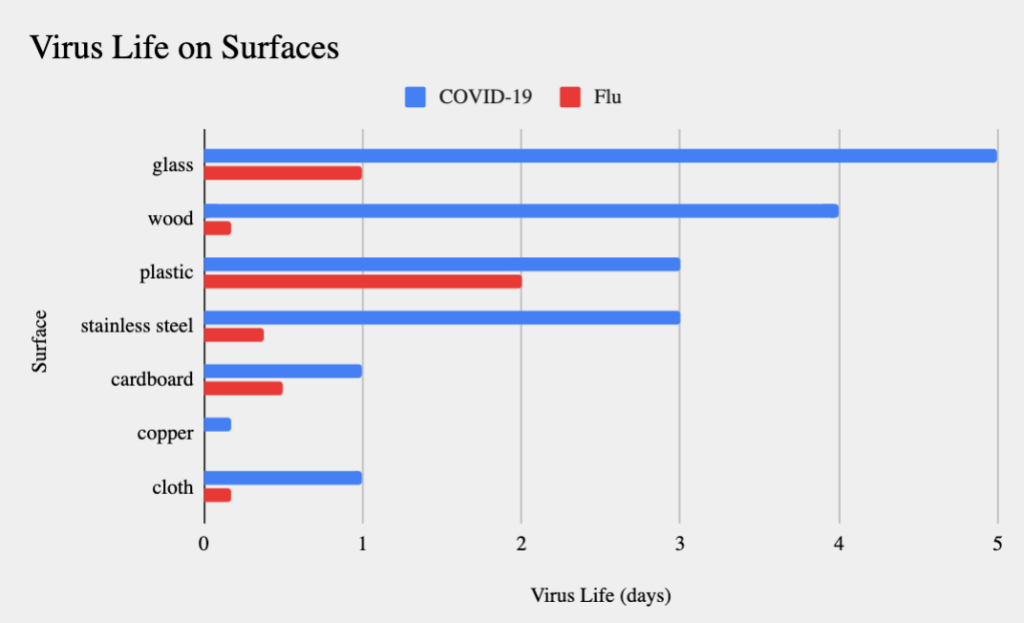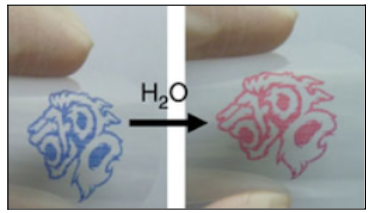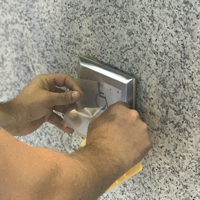Introduction to the problem
Sanitization is front and center in everyone’s lives right now. Everyone has shifted to the “new normal” since COVID became known in an effort to stay healthy. We find ourselves washing our hands more often, wiping down keys, phones, and wallets with antibacterial wipes, and using hand sanitizer after entering a building. Why do we do these things? To kill germs we may have picked up through touching surfaces other ill individuals may have touched before us.
While most feel comfortable in their own homes, a study from 2016 showed that 81% of people are concerned about the cleanliness of public spaces. [1] Looking at Figure 1, we can see two examples of communicable diseases, COVID-19 and flu, but there are hundreds more out there.

on copper surfaces was not available. [2,3]
Current solutions for this sanitation issue include setting up hand sanitizer stations frequently in strategic locations in these public and high-traffic locations. This puts the responsibility of business cleanliness and public health into the hands of each individual. For irritant contact dermatitis, hand sanitizers can cause an array of symptoms including dryness, irritation, itching, cracking, and bleeding [4]. Though rare, allergic contact dermatitis can present itself as a reaction to an ingredient in hand hygiene products as respiratory distress and other forms of anaphylactic shock. [4]
Companies commercially selling similar products to ours include Polymershapes (nanoDefense), Purehold, NeverGerms, Safe Barrier Antimicrobial Stickers, and NanoSeptic. [5-9] Though these strips are already on the market, they have many downsides. Many of these options kill microorganisms using photocatalytic reactions. [6] This means the cleaning is activated by light.
Our solution
Gecko Grain is a sanitizing sheet that can stick to any commonly touched surface and automatically provide a sufficiently clean surface after each contact without additional manual labor, power supply or sanitizing solution used. Gecko Grain is comparable to a sticker, in that the user simply unsticks the paper placeholder, and places it on their door handle, grocery cart handle, or another commonly touched surface, and it is now a self-sanitizing surface that does not require a new strip for one to three years.

Biomimicry of gecko feet was chosen due to their microfibre called setae which have antimicrobial effects, meaning it kills microorganisms including bacteria and viruses. They are also self-adhesive, which is key to our solution. Fundamental principles of our design include biodegradability, an indicator strip, and safety.
The main sheet will be made of a polyurethane thermoset – a clear, flexible material. [11] This material is 100% biodegradable and hydrophobic, meaning it repels water. [11]
The strip is estimated to last one to three years based on usage. It is clear a strip would wear down quicker in a metro station with thousands bustling by per day versus an office location with only 50 employees passing through per day. An indicator strip will be implemented to show users when the product needs to be changed.
The indicator strip will be hydrochromic polydiacetylene (PDA), a polymer chosen due to its color response to moisture. [10] Because the sheet material is hydrophobic, as it breaks down, it will begin to let water through. Once it reaches a certain level of deterioration nearing ineffectiveness, the water will trigger the indicator strip to turn from blue to red as shown in Figure 2.

To create the surface, the raw polyurethane sheet will be treated with PDMS-NH2 to give it its self-cleaning properties. [11] An indicator strip will be applied. The strip can then be attached to door handles or any other commonly touched surface for one to three years until the indicator strip is broken down and changes color. The final sheet will be clear, with the thin, colored indicator strip going across the front of the surface. Our final product will look similar to the sheets shown in Figure 3.
Most importantly, these polymers are all non-toxic to contact, even with prolonged exposure.
Results
We have already started the first phase of Gecko Grain. So far, we have chosen the base material of the sheet and indicator strip. Furthermore, in this phase, we will need assistance in the chemistry domain for continuing product development. Since this product will not interact directly with internal, biological systems, FDA approval is not mandatory. But the degree of biodegradability and biocompatibility needs to be tested. A pilot study that is required to show our product sufficiently kills germs and limits spread due to surface contact. Lastly, we will need to show our product can perform at these standards regardless of humidity, sunlight/UV, temperature, adsorption state, and pH.
Acknowledgments
I sincerely thank my team members Alexis Appelquist (University of Arkansas, Biomedical Engineering) Ericka Hewes (the University of Arkansas, Walton College of Business), and Neha Sreedharala (BMS College of Engineering, Biomedical Engineering) for utilizing their diverse skillset in conceptualizing this research.
Our team profoundly thanks Prof Dr. Abhiskek Appaji, Prof Raj R. Rao, Ph.D., and Prof Dr. Garcia Contreras for their constant guidance and mentorship throughout the program.
References
- nanoseptic.com/traveler
- health.clevelandclinic.org/how-long-will-coronavirus-survive-on-surfaces
- ncbi.nlm.nih.gov/pmc/articles/PMC3222642
- ncbi.nlm.nih.gov/books/NBK144008
- polymershapes.com/product/nanodefense
- purehold.co.uk/
- https://www.nevergerms.com
- mysafetysign.com/safe-barrier-antimicrobial-stickers-push-bar-wide-handle-wrap/sku-lb-4337
- https://www.nanoseptic.com/
- ncbi.nlm.nih.gov/pmc/articles/PMC4015324
- mdpi.com/2073-4360/11/11/1849
- mysafetysign.com/safe-barrier-antimicrobial-stickers


